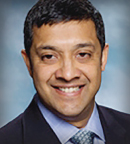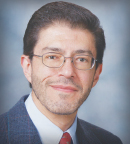In case you missed these while attending the 2020 American Society of Hematology (ASH) Annual Meeting & Exposition, below is a sampler of highlights that were not included in our first round of meeting coverage. Many of these reports are on early-phase clinical trials of agents that may raise the bar for the treatment of hematologic malignancies. We hope you will find these reports of interest.
Odronextamab Shows Early Activity in Relapsed/Refractory NHL
Odronextamab (REGN1979), a novel CD20 × CD3 bispecific antibody, continues to show antitumor activity and acceptable safety in patients with relapsed or refractory B-cell NHL, including those previously treated with CAR T-cell therapy, in extended follow-up of a phase I study.1
Patients previously treated with CAR T-cell therapy have typically run out of other treatment options. In this phase I study, in 24 patients previously treated with CAR T-cell therapy, the objective response rate was 33%, and the complete response rate was 21%. Complete responses appear to be durable, since 100% of the complete responses were still ongoing at the time of the 2020 meeting.
“Odronextamab is a novel CD20 × CD3 bispecific antibody that is an off-the-shelf, primarily outpatient treatment option for patients with relapsed or refractory B-cell NHL. In this first-in-human phase I trial, odronextamab has demonstrated compelling antitumor activity, including durable complete responses in heavily pretreated patients with follicular lymphoma and [DLBCL],” said lead author Rajat Bannerji, MD, PhD, Chief of Hematologic Malignancies at Rutgers Cancer Institute of New Jersey.

“In this first-in-human phase I trial, odronextamab has demonstrated compelling antitumor activity.”— Rajat Bannerji, MD, PhD
Tweet this quote
In 11 patients with relapsed or refractory DLBCL not previously treated with CAR T-cell therapy, the objective response rate was 55%, all of them complete responses. A total of 83% of complete responses were durable, and one patient remains in complete response at 21 months of follow-up.
Additionally, in 30 patients with relapsed or refractory follicular lymphoma, the objective response rate was 90%, and the complete response rate was 70%. A total of 81% of the complete responses were durable, and the median duration of complete response was not reached.
The toxicity profile of odronextamab was acceptable, and the maximum tolerated dose was not reached by the completion of dose escalation in the phase I study. The most frequent grade 3 or higher treatment-emergent adverse events occurring in at least 10% of patients included anemia (24.3%), transient lymphopenia (20.6%), neutropenia (18.4%; febrile, 2.2%), and hypophosphatemia (18.4%). No patient discontinued odronextamab due to cytokine-release syndrome or neurotoxicity; overall, 5.9% of patients had a treatment-emergent adverse event that led to treatment discontinuation. Additionally, no dose-dependent increases in toxicity were observed.
Cytokine-release syndrome occurred in 61% of patients. The majority of cytokine-release syndrome events were mild or moderate, and the majority of the grade 3 or higher events occurred with initial or intermediate step-up doses of odronextamab. Cytokine-release syndrome resolved with supportive care measures.
No grade 3 or higher tumor-lysis syndrome events were reported in patients with follicular lymphoma or DLBCL.
A phase II trial of odronextamab is ongoing in relapsed or refractory B-cell lymphoma.
Efficacy of Parsaclisib in Marginal Zone Lymphoma
Patients with relapsed or refractory marginal zone lymphoma not previously treated with a Bruton’s tyrosine kinase (BTK) inhibitor achieved rapid and durable responses with single-agent parsaclisib in the phase II CITADEL-204 trial.2
Parsaclisib is a potent, highly selective, next-generation PI3Kδ inhibitor that showed promising response rates in a phase I/II study in patients with previously treated B-cell malignancies. The current study, CITADEL-204, was a multicenter, open-label phase II trial of parsaclisib in patients with relapsed or refractory marginal zone lymphoma not previously treated with a BTK inhibitor.
“The use of PI3Kδ inhibitors in marginal zone lymphoma has been limited by off-target toxicities and the inability to completely block this pathway. Multiple second-generation inhibitors have been explored. Parsaclisib is uniquely designed to avoid the hepatotoxicity commonly seen with other PI3Kδ inhibitors,” said Tycel J. Phillips, MD, of the University of Michigan, Ann Arbor.

“Parsaclisib is uniquely designed to avoid the hepatotoxicity commonly seen with other PI3Kδ inhibitors.”— Tycel J. Phillips, MD
Tweet this quote
The study included patients who had received at least one prior line of therapy that did not include a BTK inhibitor. Patients received parsaclisib at 20 mg once daily for 8 weeks followed by either 20 mg once weekly or 2.5 mg daily. Preliminary data showed improved efficacy with the 2.5-mg daily dose, so most patients in the study transitioned to this dose during maintenance, and it will be the dose moving forward, he said.
In 100 patients, 72 of whom received the 2.5-mg daily dose, the overall response rate was 57% in both the overall population and the daily-dosed patients. The median duration of response was 12 months overall and not reached for the daily-dosed group. Median progression-free survival was 19.4 months and not reached, respectively.
Comparable efficacy was observed in patients diagnosed with nodal, extranodal, or splenic marginal zone lymphoma, Dr. Phillips reported.
Treatment with parsaclisib was generally well tolerated without unexpected toxicities. Of note, no significant elevations in liver enzymes were observed. Some patients did discontinue treatment because of diarrhea or colitis, with a median time to onset of 5.3 months and a median time to improvement of 12 days.
“We feel that parsaclisib is a highly potent second-generation PI3Kδ inhibitor shown to be a very effective and safe treatment in patients with relapsed marginal zone lymphoma,” Dr. Phillips commented.
Triplet Combination Achieves High Response Rate in Relapsed/Refractory CLL
The triplet combination of umbralisib (TGR-1202) plus ublituximab (TGTX-1101), referred to as U2, plus venetoclax showed encouraging efficacy in patients with relapsed or refractory chronic lymphocytic leukemia (CLL), including those who were refractory to prior BTK inhibitor therapy, according to results of a phase I/II study.3
After 7 to 12 cycles of treatment, the objective response rate was 100% with the triplet regimen, with a high rate of undetectable measurable residual disease (MRD).
Ublituximab is an anti-CD20 monoclonal antibody that has enhanced antibody-dependent cellular toxicity compared with the standard of care, rituximab; umbralisib, a novel small-molecule inhibitor targeting PI3Kδ and CK1ε, has a limited effect on regulatory T cells and improved tolerability in prior studies. Venetoclax targets the BCL2 protein, which supports cell proliferation and is overexpressed in many patients with CLL.
“Given the growing use of BTK inhibitors in the first-line setting, we aimed to develop an effective venetoclax-containing regimen of limited duration for our relapsed/refractory patients,” said lead investigator Paul M. Barr, MD, the James P. Wilmot Cancer Institute of the University of Rochester Medical Center in New York.

Paul M. Barr, MD
The multicenter dose-finding phase I trial established the recommended phase II dose of ublituximab at 900 mg and umbralisib at 800 mg (U2) to be administered with the standard 5-week venetoclax ramp-up to 400 mg.
All patients received three cycles of U2 followed by venetoclax, which was continued for nine total cycles. Patients were assessed for response after completing 12 cycles of treatment. At the time of the 2020 meeting, 43 patients were enrolled and evaluable for safety; 39 patients completed the first 3 cycles of treatment and were evaluable for efficacy.
The median age of patients was 64 years, and the majority were male. The median number of prior therapies was two, and 33% of patients were refractory to their immediate prior therapy (74% had prior anti-CD20 therapy, 70% had prior chemoimmunotherapy, 58% had prior BTK inhibitor therapy, 5% had a prior PI3K inhibitor, and 2% had prior venetoclax). Among the 25 patients treated with a BTK inhibitor, 52% were refractory.
A total of 79% of patients had at least one high-risk feature, including 11q deletion (30%), 17p deletion (26%), TP53 mutation (18%), NOTCH1 mutation (27%), or SF3B1 mutation (15%); 74% of patients were IGHV unmutated.
All-cause adverse effects of any grade occurring in at least 20% of patients included infusion reactions (60%), anemia (56%), thrombocytopenia (53%), neutropenia (51%), creatine decrease (49%), leukopenia (47%), fatigue (42%), and diarrhea (40%). The most common grade 3 or 4 adverse events were neutropenia (21%), leukopenia (12%), infusion reaction (7%), anemia (5%), and diarrhea (5%).
Grade 3 or 4 adverse events of special interest included lung infection/pneumonia (7%), colitis (5%), tumor-lysis syndrome (2%), and rash (2%). Dose reductions for umbralisib were needed in two patients (4%); treatment discontinuation occurred with umbralisib and venetoclax in four (9%) and two patients (4%), respectively. No pneumonitis events or grade 3 liver enzyme elevations were reported.
“Three cycles of U2 induction appeared effective at reducing the tumor-lysis risk. A total of 6 and 21 patients, respectively, had high and medium tumor-lysis syndrome risk, and most were relegated to having low tumor-lysis syndrome risk after induction. This represented an 81% relative reduction in tumor-lysis syndrome risk after the three U2 cycles,” Dr. Barr said. No clinical or laboratory tumor-lysis syndrome occurred during the venetoclax ramp-up after patients received U2.
After three cycles of U2 induction, the objective response rate was 77% (all partial responses), with 23% having stable disease. Among 31 patients who received seven cycles of treatment, the objective response rate was 100% (all partial responses). Among 27 patients who completed all 12 cycles, the objective response rate was 100% (41% complete response and 59% partial response).
At cycle 3, the objective response rate was 64% among the BTK-refractory population and 74% among those who received a prior BTK inhibitor.
Overall, 96% of patients had undetectable MRD (< 0.01%) in the peripheral blood and 77% in the bone marrow.
Median progression-free survival was 15.6 months. One patient experienced disease progression 10 months after reaching undetectable MRD in the peripheral blood and bone marrow and discontinued therapy.
Based on this study, expansion cohorts will evaluate the triplet regimen in Richter transformation and mantle cell lymphoma. A separate phase II study, ULTRA-V, will explore the regimen in treatment-naive and relapsed/refractory patients with CLL.
Durable Responses With LOXO-305 in Heavily Pretreated CLL/SLL
LOXO-305, an investigational, highly selective, noncovalent BTK inhibitor, led to a 63% objective response rate in heavily pretreated patients with CLL and small lymphocytic lymphoma (SLL), according to investigator assessment in the phase I/II -BRUIN trial.4
Among 139 patients with CLL/SLL who were evaluable for efficacy and treated across all dose levels, there were 88 responses (69 partial responses and 19 partial responses with ongoing lymphocytosis). A total of 45 patients had stable disease, 1 had progressive disease, and 5 discontinued treatment prior to their first response assessment and were considered evaluable.
“The data presented at ASH reveal an incredibly encouraging and consistent safety and efficacy profile for LOXO-305 in heavily pretreated patients with CLL and SLL, regardless of previous therapies, reasons for discontinuations of those therapies, or presence of resistance mutations,” said presenting author Anthony R. Mato, MD, Director of the CLL Program at Memorial Sloan Kettering Cancer Center, New York.

“We are increasingly in need of new therapies for patients who have been previously treated with a covalent BTK inhibitor.”— Anthony R. Mato, MD
Tweet this quote
“We are increasingly in need of new therapies for patients who have been previously treated with a covalent BTK inhibitor. LOXO-305 may allow us to continue treating patients in the same biologic class before attempting more complicated therapeutic approaches,” he added.
The phase I/II trial enrolled 323 patients with CLL/SLL (n = 170), mantle cell lymphoma (n = 61), Waldenström macroglobulinemia (n = 26), and other B-cell lymphomas (n = 66).
Patients with CLL/SLL received a median of three prior lines of therapy, including BTK inhibitor (86%), anti-CD20 antibody (90%), chemotherapy (82%), venetoclax (34%), PI3K inhibitor (21%), CAR T-cell therapy, and allogeneic transplant (2%).
A total of 88% of patients with CLL/SLL remain on study treatment as of the data cutoff, Dr. Mato said. Of the 88 patients still responding to treatment, all except 5 remain on treatment. Four patients had disease progression; one patient achieved a partial response and chose to discontinue pursuit of a transplant. The longest followed patient in response is still on treatment at 17.8 months.
At a median follow-up of 6 months for efficacy, the objective response rates were consistent across multiple patient subgroups. For those previously treated with a BTK inhibitor (n = 121), the objective response rate was 62% and increased to 84% at 10 months.
In patients whose cancer harbored a BTK C481 mutation (n = 24), the objective response rate was 71%, compared with 61% in those without the mutation (n = 65). In those with del(17p), TP53 mutation, or both (n = 28), the objective response rate was 79%.
Efficacy was observed in patients regardless of their BTK experience or other prior therapies. The high overall response rate was similar across subgroups, even in the most heavily pretreated patients in whom five prior U.S. Food and Drug Administration (FDA)-approved therapies had failed.
Safety was evaluable for all 323 patients enrolled on study. The most commonly reported adverse events of any grade were fatigue (20%), diarrhea (17%), and contusion (13%). Atrial arrhythmia and hemorrhage rates were very low and unrelated to study treatment. Dose interruptions were reported in 8% of patients, reductions in 2.2%, and permanent treatment discontinuations due to treatment-related adverse events occurred 1.5% of patients. There were no dose-limiting toxicities reported, and the maximum tolerated dose was not reached.
Phase III studies of LOXO-305 are planned in patients with CLL/SLL who experienced disease progression on or were intolerant to a covalent BTK inhibitor, as well as treatment-naive CLL/SLL.
CARTITUDE Update: Durable Responses in Myeloma
For patients with heavily pretreated multiple myeloma, the early and deep responses seen with the novel CAR T-cell construct ciltacabtagene autoleucel have also been durable, CARTITUDE-1 investigators reported.5
In the study of 97 patients who received ciltacabtagene autoleucel, which targets B-cell maturation antigen (BCMA), the overall response rate was 96.9%, with a median duration of response not reached after 12.4 months of follow-up, reported Deepu Madduri, MD, of Mount Sinai Medical Center in New York.

“We saw how heavily pretreated these patients were, and to see a one-time treatment [like ciltacabtagene autoleucel] get these kinds of response rates is quite exceptional.”— Deepu Madduri, MD
Tweet this quote
“We saw how heavily pretreated these patients were, and to see a one-time treatment get these kinds of response rates is quite exceptional. What’s even more impressive is that 72% of these patients were still maintaining their response at the time of data cutoff,” she said.
Ciltacabtagene autoleucel has been granted a Breakthrough Therapy designation for relapsed or refractory multiple myeloma by the U.S. Food and Drug Administration.
Dr. Madduri reported combined results from 29 patients in phase Ib and 68 patients in phase II of the CARTITUDE-1 trial. Of the 94 (96.9%) who responded, 67% achieved stringent complete responses; 25.8%, very good partial responses or better; and 4.1%, partial responses. Among 57 patients evaluable for MRD, 53 (93%) were MRD-negative. Of this group, 49 had at least a very good partial response. At the time of data cutoff, 70 patients had an ongoing response.
At a median follow-up of 12.4 months, the 12-month progression-free survival rate was 76%, with the median not reached. The 12-month overall survival rate was 88.5%, with the median also not reached.
Cytokine-release syndrome of any grade occurred in 92 patients but was grade 3 or 4 for just 4 patients. Neurotoxicities occurred in 20 patients, of whom 10 were grade 3 or 4. Immune effector cell–associated neurotoxicity syndrome occurred in 16 patients, with 2 having grade ≥ 3; the median time to onset was 8 days, with a median time to recovery of 4 days.
Investigators have now implemented mitigation strategies, including allowing patients to have more bridging chemotherapy, more aggressive steroid use for early immune effector cell–associated neurotoxicity syndrome, and extensive monitoring.
Vodobatinib Efficacious in CML Regardless of Prior Ponatinib
In a phase I study, approximately two-thirds of patients with chronic-phase chronic myeloid leukemia (CML) achieved a major cytogenetic response to the oral BCR-ABL1 tyrosine kinase inhibitor vodobatinib, regardless of whether they had received prior ponatinib.6
“We have seen efficacy in a heavily pretreated patient population, and the efficacy seems to be comparable for ponatinib-naive and ponatinib-treated patients. Responses are present and durable, despite a number of prior therapies, including prior tyrosine kinase inhibitors,” said Jorge E. Cortes, MD, of Georgia Cancer Center in Augusta.

Jorge E. Cortes, MD
Vodobatinib is a novel third-generation tyrosine kinase inhibitor that has shown efficacy against wild-type and mutated BCR-ABL1 and other relevant mutations in CML. The drug was designed to be potent and selective, he said.
The phase I multicenter study evaluated vodobatinib in patients with chronic-phase CML in whom at least three prior tyrosine kinase inhibitors had failed, including 15 who were ponatinib-naive and 16 previously treated with ponatinib. Patients received escalating doses of vodobatinib (12–240 mg/d) in 28-day cycles.
Across all doses, 21 (68%) patients had a major cytogenetic response to vodobatinib, with similar efficacy seen regardless of prior treatment. Major cytogenetic responses were achieved by 67% of ponatinib-naive patients and 69% of patients who previously received ponatinib. Molecular responses deepened over time, with a trend for better responses in patients receiving the optimal dose of at least 174 mg.
Dr. Cortes noted that the drug was well tolerated in both cohorts. A multinational phase II study is ongoing in patients who have failed to respond to or are intolerant of ponatinib therapy.
DISCLOSURE: Dr. Bannerji has received research funding from Regeneron Pharmaceuticals, AbbVie, and F. Hoffmann–La Roche Ltd/Genentech, Inc and Pharmacyclics, an AbbVie Company; and reports that his spouse is an employee of Sanofi-Pasteur. Dr. Phillips has served as a consultant for Incyte, Seattle Genetics, Bristol Myers Squibb, Bayer, Pharmacyclics, AbbVie, AstraZeneca, BeiGene, Karyopharm, and Cardinal Health; has received travel expenses from Seattle Genetics; and has received research funding from Bayer and AbbVie. Dr. Barr has served as a consultant for Seattle Genetics, Celgene, TG Therapeutics, Verastem, Janssen, AbbVie/Pharmacyclics, Morphosys, Genentech, Merck, AstraZeneca, and Gilead; and has received research funding from TG Therapeutics, AbbVie/Pharmacyclics, and AstraZeneca. Dr. Mato has served as a consultant for BeiGene, LOXO, Genentech, Janssen, AstraZeneca, AbbVie, Adaptive, TG Therapeutics, and Pharmacyclics, an AbbVie Company; has received research funding from LOXO, Genentech, Janssen, AstraZeneca, AbbVie, Adaptive, TG Therapeutics, and Pharmacyclics, an AbbVie Company; and has served on a data and safety monitoring board for TG Therapeutics. Dr. Madduri has served as a consultant for Celgene, AbbVie, Foundation Medicine, Takeda, Janssen, Legend, Kinevant, and GlaxoSmithKline; has received honoraria from Celgene, AbbVie, Foundation Medicine, Takeda, Janssen, Legend, Kinevant, and GlaxoSmithKline; and has served on the speakers bureau and Board of Directors/advisory committee for Legend, Kinevant, and GlaxoSmithKline. Dr. Cortes has served as a consultant for Takeda, Pfizer, BioPath Holdings, BiolineRx, Daiichi Sankyo, Jazz Pharmaceuticals, and Novartis; has received research funding from Merus, Sun Pharma, Takeda, Pfizer, BioPath Holdings, Telios, Astellas, Amphivena Therapeutics, Arog, Bristol Myers Squibb, Daiichi Sankyo, Immunogen, Jazz Pharmaceuticals, and Novartis; and has served on the Board of Directors or advisory committee for BioPath Holdings.
REFERENCES
1. Bannerji R, Allan JN, Arnason JE, et al: Odronextamab (REGN1979), a human CD20 × CD3 bispecific antibody, induces durable, complete responses in patients with highly refractory B-cell non-Hodgkin lymphoma, including patients refractory to CAR T therapy. 2020 ASH Annual Meeting & Exposition. Abstract 400. Presented December 6, 2020.
2. Phillips TJ, Corradini P, Gurion R, et al: Phase 2 study evaluating the efficacy and safety of parsaclisib in patients with relapsed or refractory marginal zone lymphoma (CITADEL-204). 2020 ASH Annual Meeting & Exposition. Abstract 338. Presented December 6, 2020.
3. Barr PM, Ma S, Zent CS, et al: A phase 1/2 study of umbralisib, ublituximab and venetoclax in patients with relapsed or refractory chronic lymphocytic leukemia (CLL). 2020 ASH Annual Meeting & Exposition. Abstract 3137. Presented December 4, 2020.
4. Mato AR, Pagel JM, Coombs CC, et al: LOXO-305, a next generation, highly selective, non-covalent BTK inhibitor in previously treated CLL/SLL: Results from the phase 1/2 BRUIN study. 2020 ASH Annual Meeting & Exposition. Abstract 542. Presented December 7, 2020.
5. Madduri D, Berdeja JG, Usmani SZ, et al: CARTITUDE-1: Phase 1b/2 study of ciltacabtagene autoleucel, a B-cell maturation antigen-directed chimeric antigen receptor T cell therapy, in relapsed/refractory multiple myeloma. 2020 ASH Annual Meeting & Exposition. Abstract 177. Presented December 5, 2020.
6. Cortes JE, Saikia T, Kim DW, et al: Phase 1 trial of vodobatinib, a novel oral BCR-ABL1 tyrosine kinase inhibitor: Activity in CML chronic phase patients failing TKI therapies including ponatinib. 2020 ASH Annual Meeting & Exposition. Abstract 652. Presented December 7, 2020.

